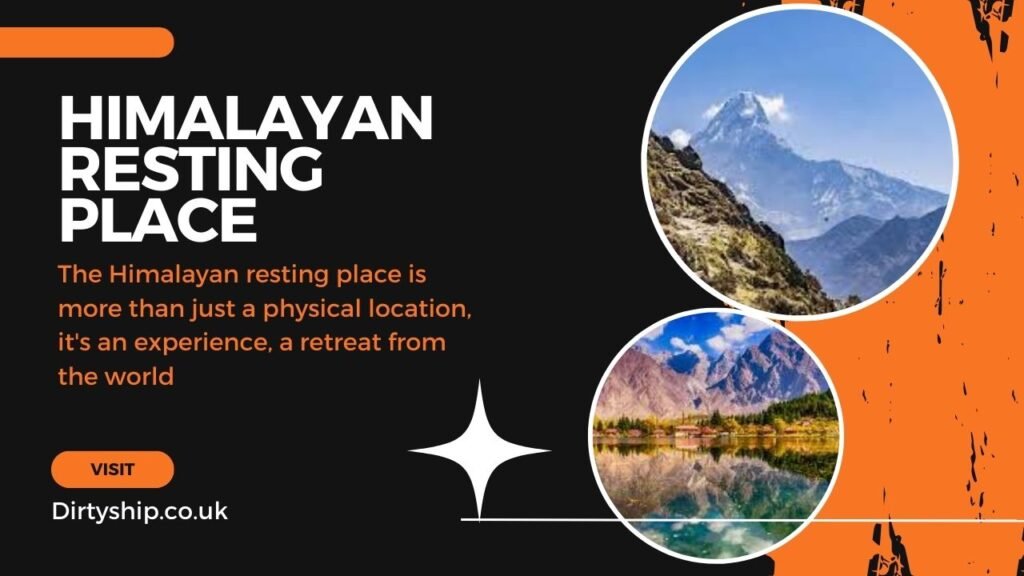Introduction
The Himalayas, commonly known as the abode of snow, stretch across five countries: Bhutan, China, India, Nepal, and Pakistan.Far more than a breathtaking range of towering peaks, this majestic landscape is a source of fascination for explorers, pilgrims, and adventure seekers. Embedded within this awe-inspiring region is the concept of the Himalayan resting place a tranquil sanctuary that offers refuge from the chaos of modern life, allowing for a deep spiritual and natural connection. In this article, we explore the profound allure and significance of these Himalayan resting places, touching on their cultural, spiritual, and ecological relevance.
The Himalayan Resting Place: A Tranquil Haven in the Mountains
The Himalayan resting place is more than just a physical location, it’s an experience, a retreat from the world where peace and mindfulness take centre stage.Surrounded by fresh mountain air, peaceful ambiance, and breathtaking vistas, these locations offer an ideal environment for reflection and unwinding.Travellers and spiritual seekers alike are drawn to the Himalayan resting place for its unmatched sense of serenity. It is here, in the stillness of nature, that one can truly disconnect from the pressures of daily life and reconnect with their inner self.

Cultural and Spiritual Significance
For centuries, the Himalayas have held deep spiritual meaning in various cultures, particularly in Hinduism and Buddhism. The Himalayan resting place is often seen as a site for meditation, prayer, and self-discovery. Many sacred temples, monasteries, and hermitages are nestled in the remote folds of these mountains, serving as pilgrimage sites where individuals seek spiritual enlightenment. The cultural heritage linked to these sanctuaries further enriches their mystical allure, intertwining ancient traditions with the natural beauty of the region.
Ecological Importance of Himalayan Resting Places
Beyond their spiritual appeal, Himalayan resting places also play a crucial role in preserving the region’s unique ecology. The pristine environment of these secluded areas supports diverse ecosystems that are home to rare flora and fauna. Conservation efforts in the region have focused on protecting these fragile habitats while ensuring that visitors can enjoy the serenity they offer without harming the environment. The sustainable development of the Himalayan resting place reflects a balance between preserving natural beauty and promoting eco-friendly tourism.
A Journey to Inner Peace
For those seeking solitude, the Himalayan resting place is more than just a destination it’s a transformative journey. Whether you are an adventurer, a spiritual seeker, or someone simply looking for a break from the modern world, the peace and tranquillity of these sanctuaries provide a unique opportunity for self-reflection. Immersed in the natural beauty of the Himalayas, individuals can achieve a profound sense of calm, making the Himalayan resting place a cornerstone for mental and emotional well-being.
The Magnificence of the Himalayas
The Himalayas, known as the Abode of Snow, are globally renowned for their breathtaking landscapes and spiritual importance. Stretching across five nations Bhutan, China, India, Nepal, and Pakistan this remarkable mountain range features some of the tallest summits on the planet, including the renowned Mount Everest.The Himalayan Resting Place capitalises on this natural beauty, offering an escape where guests can blend relaxation with exploration, all within the awe-inspiring Himalayan backdrop.
What Sets the Himalayan Resting Place Apart
- A Sanctuary for the Mind and Soul
The Himalayan Resting Place is not just a destination; it’s a haven for those seeking spiritual renewal. Beyond being a physical location, it embodies the concept of a spiritual sanctuary, where visitors embark on a journey of self-discovery and inner peace. Situated in remote, hard-to-reach areas, the retreat emphasises that finding true tranquillity often involves a deeper, more personal expedition both physically and mentally.
- A Rich Historical Legacy
For centuries, the Himalayas have been a pilgrimage site for seekers of enlightenment. These journeys to remote Himalayan resting places often represent more than just a physical trek they symbolise overcoming life’s challenges and achieving higher consciousness. Many of these resting places are steeped in myths and legends, enriching their mystical appeal and drawing visitors who seek both spiritual growth and adventure.
Modern-Day Escapes in the Himalayas
Today, the Himalayan Resting Place attracts a diverse range of travellers, from spiritual seekers to adventurers and tourists looking for a retreat from the pressures of modern life.These sanctuaries offer a harmonious blend of peace, rejuvenation, and exploration. Whether you’re looking to meditate in the silence of the mountains or embark on a thrilling trek, the Himalayan Resting Place provides a transformative experience for body, mind, and spirit.With its serene environment and unique combination of relaxation and adventure, the Himalayan Resting Place stands out as a perfect retreat for those seeking to reconnect with nature and themselves.
Himalayan Resting Place Unmatched Comfort in Nature
- Luxury Meets Coziness
The Himalayan Resting Place epitomises a harmonious blend of luxury and nature. Each accommodation is thoughtfully designed to offer a cosy yet lavish experience, seamlessly integrating with the surrounding environment. Whether you opt for a rustic cabin, a charming cottage, or an expansive suite, every space provides a warm, inviting ambiance. The design ensures that while you indulge in comfort, you also remain closely connected to nature, making it the perfect retreat for both relaxation and rejuvenation.
- Breathtaking Views
A defining feature of the Himalayan Resting Place is its mesmerising vistas. From the comfort of your accommodation, you’re treated to panoramic views of majestic mountains, serene valleys, and dense forests. Imagine waking up to the sight of snow-covered peaks shimmering under the morning sun or ending your day with the soft hues of sunset colouring the sky. These natural spectacles elevate the overall experience, offering tranquillity and a deep connection with the Himalayan landscape.
Notable Himalayan Resting Places
- Lumbini, Nepal
Lumbini stands as one of the most revered spiritual resting places in the Himalayas. As the birthplace of Siddhartha Gautama, later known as Buddha, this UNESCO World Heritage site holds immense significance for pilgrims from around the world. Situated in Nepal’s Terai plains, Lumbini features the Maya Devi Temple, marking Buddha’s exact birthplace. The peaceful gardens and monasteries, built by various Buddhist nations, make this a serene sanctuary for reflection and spiritual growth.
- Rishikesh, India
Renowned as the Yoga Capital of the World, Rishikesh is nestled along the sacred Ganges River in Uttarakhand, India. It serves as a global hub for those seeking spiritual enlightenment and physical well-being through yoga and meditation. The surrounding hills and forests are home to numerous retreats and ashrams, offering visitors an immersive experience focused on mindfulness and inner peace. The town’s tranquil setting makes it an ideal Himalayan resting place for anyone looking to rejuvenate both body and soul.
- Paro Taktsang, Bhutan
Paro Taktsang, commonly known as the Tiger’s Nest Monastery, is one of Bhutan’s most iconic landmarks. Perched dramatically on a cliff 900 metres above the Paro Valley, it holds immense spiritual significance. Legend has it that Guru Rinpoche, the founder of Tibetan Buddhism, meditated here in the 8th century. The journey to this sacred site involves a challenging trek, but the reward is worth every step a profound sense of serenity coupled with awe-inspiring views of the Himalayan landscape.
- Dharamsala, India
Located in Himachal Pradesh, India, Dharamsala serves as the residence of the Dalai Lama and the centre of the Tibetan government-in-exile. It is a prominent destination for spiritual seekers, offering meditation centres and monasteries amidst the breathtaking Dhauladhar mountain range. Visitors are drawn to Dharamsala for its peaceful atmosphere and deep connection to Tibetan spirituality, making it an ideal Himalayan resting place for those seeking enlightenment and tranquillity
Activities and Experiences at the Himalayan Resting Place: Embracing Adventure and Tranquillity
- Hiking and Trekking Adventures
For outdoor enthusiasts seeking both adventure and breathtaking views, the Himalayan Resting Place is a paradise for hikers and trekkers. The surrounding trails cater to all skill levels, offering a variety of experiences from gentle walks to more challenging hikes that take you through higher altitudes. Whether you’re exploring the lush forests or crossing crystal-clear streams, each trail promises a chance to encounter the region’s diverse flora and fauna. Along the way, you’ll be rewarded with panoramic views of the majestic Himalayan mountains, making it a must-visit destination for nature lovers.
- Yoga and Meditation for Inner Peace
If you’re looking to find inner calm and rejuvenate your spirit, the Himalayan Resting Place provides tranquil settings for yoga and meditation. Surrounded by the awe-inspiring Himalayan landscape, these sessions are designed to help you reconnect with yourself and reduce the stress of daily life. Tailored to both seasoned practitioners and beginners alike, these practices aim to improve your physical, emotional, and mental well-being. The serene environment allows you to focus on achieving balance and inner tranquillity, making your retreat experience truly transformative.
- Cultural Immersion and Local Experiences
The Himalayan Resting Place offers more than just outdoor activities. For a deeper connection with the region, guests can engage in immersive cultural experiences. From learning traditional crafts to participating in local festivals, these activities allow you to experience the vibrant heritage of the area firsthand. Additionally, opportunities to interact with local communities provide a glimpse into their way of life, offering meaningful insights into the region’s rich history and traditions.
- Thrilling Adventure Sports
For adrenaline seekers, the Himalayan Resting Place offers an exciting range of adventure sports. Whether it’s mountain biking through rugged trails, rock climbing up steep cliffs, or paragliding over the scenic landscape, there’s something for every thrill-seeker. You can also experience the rush of white-water rafting on the area’s rivers, with experienced guides ensuring both safety and adventure. No matter the activity, the stunning surroundings and expertly guided experiences will leave you with memories of a lifetime.
Climate and Weather Insights
The weather at the Himalayan Resting Place varies depending on the altitude and season. Summers are generally mild, making it the perfect time for outdoor exploration. In contrast, winters can be quite cold with significant snowfall, transforming the landscape into a winter wonderland. It’s essential to check weather conditions before your trip to ensure you’re well-prepared, particularly during the colder months. Proper planning will ensure you can make the most of your visit, whether you’re trekking, meditating, or partaking in more adventurous pursuits.

Planning Your Visit to the Himalayan Resting Place: Practical Tips and Insights
- Best Time to Visit
Choosing the ideal time to visit the Himalayan resting place depends on the type of experience you’re seeking. The prime travel season runs from April to October, during which the weather is mild and perfect for outdoor activities like hiking and exploration. For those looking for a quieter, more serene experience, the winter months offer snow-blanketed vistas and fewer visitors, allowing you to fully immerse yourself in the peaceful beauty of the region. Decide whether you prefer a vibrant or tranquil atmosphere and plan your visit accordingly.
- Getting to the Himalayan Resting Place
Reaching the Himalayan resting place involves a scenic journey that often begins with a flight to nearby major cities such as Delhi or Kathmandu. From these hubs, travellers typically continue by road or connecting domestic flights to the retreat. The trip to the resting place offers stunning views of the majestic Himalayas, making the journey itself an unforgettable part of your adventure. For a truly immersive experience, consider hiring a local guide who can share insights and stories about the landscape as you make your way to this serene destination.
- Packing Essentials for Your Trip
When preparing for your journey, it’s essential to consider both the weather and the activities you plan to participate in. Layered clothing is recommended to handle the fluctuating temperatures, and sturdy hiking boots are a must for navigating the rugged terrain. Don’t forget wellness items like a yoga mat or meditation cushion, if you plan to partake in the retreat’s wellness programs. Additionally, bring sunscreen, a wide-brimmed hat, and your camera to capture the breathtaking beauty of the Himalayan resting place.
The Impact of Technology on Himalayan Retreats
With the rise of modern technology, even remote Himalayan retreats are benefiting from improved infrastructure and communication systems. These advancements are making the resting place more accessible to visitors while also enhancing their overall experience. However, it’s crucial to integrate technology in a way that doesn’t disrupt the natural and cultural environment of these sacred spaces. Responsible use of technology can support local communities, offering them new economic opportunities while ensuring the preservation of the pristine landscapes and rich cultural heritage that define the Himalayan resting place.
The Future of Himalayan Resting Places: Sustainable Tourism and Conservation
As tourism in the Himalayas continues to grow, it’s more important than ever to strike a balance between promoting travel and protecting the environment. Sustainable initiatives such as eco-friendly lodgings, waste management systems, and community-driven tourism projects aim to reduce the environmental footprint of visitors. These efforts ensure that the Himalayan resting place remains an unspoiled destination for future generations.
Preserving Cultural Heritage
Equally vital to the region’s future is the preservation of its unique cultural identity. With increased tourism comes the risk of diluting local traditions and customs. It’s essential to support local crafts, languages, and practices to ensure that the Himalayan resting place retains its deep cultural and spiritual significance. Through responsible tourism, visitors can not only enjoy the beauty of the Himalayas but also contribute to preserving its rich heritage.
FAQs: Visiting the Himalayan Resting Place
1. What is the best time to visit the Himalayan resting place?
The most popular time to visit is between April and October when the weather is ideal for outdoor activities. However, if you’re looking for a quieter, snow-filled experience, the winter months can provide a serene and less crowded environment.
2. How do I get to the Himalayan resting place?
You can reach the Himalayan resting place by flying into major nearby cities such as Delhi or Kathmandu. From there, you can either take a connecting domestic flight or travel by road to the retreat. The journey offers spectacular views of the Himalayas, making the trip part of the overall experience.
3. What should I pack for my visit?
It’s best to pack layered clothing to accommodate varying temperatures, especially if you plan on hiking. Bring comfortable footwear, sunscreen, a hat, and a camera. If you’re participating in wellness activities, consider packing items like a yoga mat or meditation gear.
4. Is there internet access at the Himalayan resting place?
While technology has improved accessibility to the region, it’s important to check with your retreat regarding connectivity. Many locations now offer limited internet access, but some prefer to maintain a tech-free environment to promote complete relaxation and mindfulness.
5. How can I contribute to sustainable tourism in the Himalayas?
You can support sustainability by choosing eco-friendly accommodations, reducing waste, and respecting local cultures and traditions. Participating in community-based tourism initiatives is also a great way to contribute to the preservation of the region’s environment and heritage.
Conclusion
A visit to the Himalayan resting place offers not only an escape into nature but also an opportunity to immerse yourself in the region’s rich cultural heritage. Whether you’re drawn by the stunning landscapes, spiritual retreats, or the peaceful environment, the Himalayan resting place is a destination that balances modern convenience with the need for conservation and preservation. By practising responsible tourism, you can help ensure this unique location continues to thrive as a place of tranquillity and cultural significance for generations to come.
For any kind of updates please visit Dirtyship



